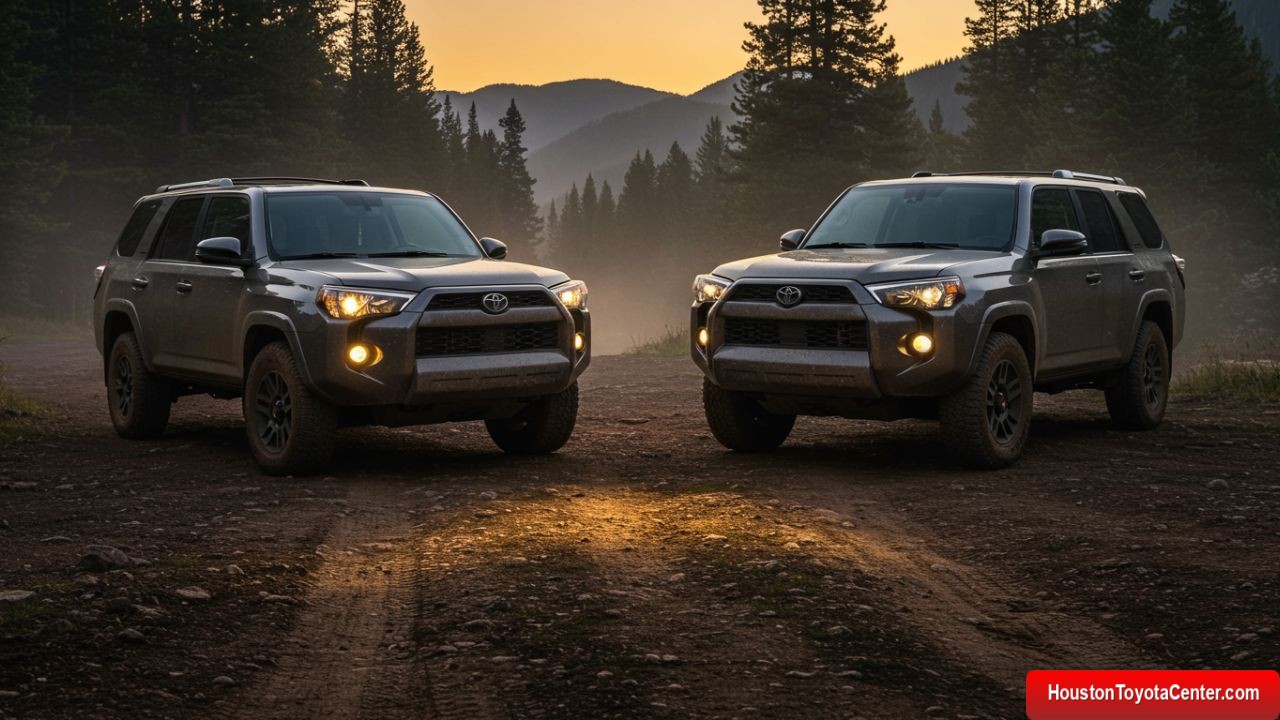The Toyota 4Runner is one of the most iconic midsize SUVs in the U.S. Known for its rugged build, time-tested reliability, and trail-conquering capabilities, it has become a staple for off-road enthusiasts and families alike. Within the 4Runner lineup, two trims often spark comparison: the SR5 and the TRD Pro.
While both represent the same body-on-frame platform, their purpose and value proposition differ significantly. This article explores everything you need to know to decide which version delivers better off-road value — not just on paper, but where it matters most: the dirt, mud, snow, and rock.
Overview of the 4Runner Lineup
The 2025 Toyota 4Runner comes in several trims, but the SR5 and TRD Pro sit on opposite ends of the spectrum in terms of price and equipment. Here’s a quick breakdown:
| Trim | Starting MSRP (2025) | Key Purpose |
|---|---|---|
| SR5 | ~$42,000 | Base-level functionality & comfort |
| TRD Pro | ~$58,000 | High-end off-road performance |
Powertrain and Drivetrain: Same Heart, Different Muscle
Both the SR5 and TRD Pro are powered by Toyota’s trusted 4.0-liter V6 engine producing 270 horsepower and 278 lb-ft of torque. Paired with a 5-speed automatic transmission, the powertrain isn’t about speed — it’s about reliability and torque delivery in rough terrain.
FREE: Quickly identify and understand problems with your vehicle 🚘
CLICK HEREHowever, where they differ is in the drivetrain and suspension systems:
- SR5 comes standard with rear-wheel drive (RWD), though 4WD is optional.
- TRD Pro features standard part-time 4WD with an electronically controlled locking rear differential.
| Feature | 4Runner SR5 | 4Runner TRD Pro |
|---|---|---|
| Engine | 4.0L V6 | 4.0L V6 |
| Transmission | 5-Speed Auto | 5-Speed Auto |
| Drivetrain | RWD / Optional 4WD | Standard 4WD |
| Differential Lock | No | Yes |
If you’re serious about off-roading, the TRD Pro offers better standard hardware. The SR5, while capable, requires add-ons to reach a comparable drivetrain setup.
Suspension and Ground Clearance: Articulation Matters
When it comes to off-roading, suspension geometry and ground clearance can make or break your experience. Here’s where the TRD Pro truly shines.
- The SR5 rides on a traditional suspension tuned more for daily comfort and light trails.
- The TRD Pro gets TRD-tuned FOX high-performance shocks, a 1-inch front lift, and specially engineered springs for better approach and departure angles.
| Feature | SR5 | TRD Pro |
|---|---|---|
| Front Suspension | Independent | TRD FOX Shocks |
| Rear Suspension | 4-Link | TRD-Tuned |
| Ground Clearance | 9.0 inches | 9.6 inches |
| Approach Angle | ~30° | ~33° |
| Departure Angle | ~26° | ~26° |
While 0.6 inches may not sound like much, in rocky terrain or deep ruts, it could mean the difference between a clean exit or underbody damage.
Off-Road Features: More Than Just Looks
The TRD Pro is a factory-ready trail machine, but the SR5 needs some help. Here’s what each offers:
4Runner SR5:
- Available part-time 4WD system with Active Traction Control (A-TRAC)
- Hill Start Assist Control (HAC)
- Optional Downhill Assist Control (DAC)
- Skid plates (minimal)
4Runner TRD Pro:
- Multi-Terrain Select and Crawl Control
- TRD skid plate and underbody armor
- Locking rear differential
- FOX shocks
- All-terrain tires
- Off-road tuned traction control
The TRD Pro’s Multi-Terrain Select lets you dial in the best traction for mud, rocks, sand, or snow. Crawl Control acts like low-speed off-road cruise control, ideal for steep inclines or descents.
Interior and Tech: Rugged vs. Refined
Surprisingly, both trims offer similar levels of infotainment and interior tech, including:
- 8-inch touchscreen
- Apple CarPlay & Android Auto
- Amazon Alexa integration
- Rearview camera
- Toyota Safety Sense P
However, the TRD Pro adds creature comforts and rugged touches, such as:
- SofTex-trimmed seats with red stitching
- Premium JBL audio system
- TRD logos and all-weather floor mats
- Moonroof
In contrast, the SR5 interior is more basic, focusing on function over flair. You’ll still get a comfortable cabin, but not the same off-road-focused vibe.
Towing Capacity and Payload: More Similar Than Different
Despite their differences, the SR5 and TRD Pro both offer:
- Towing capacity: up to 5,000 lbs
- Payload: ~1,550 lbs
If you need to tow a trailer, boat, or a couple of dirt bikes, either trim will handle it, provided you add the proper hitch and wiring harness.
Wheels and Tires: Grip Is Critical
One area that shouldn’t be overlooked is the tire package:
- SR5: 17-inch alloy wheels with highway-terrain (HT) tires
- TRD Pro: 17-inch black TRD wheels with Nitto Terra Grappler all-terrain tires
The TRD Pro’s wheels and tires provide superior grip in sand, snow, and rocks. The SR5’s setup is better for highway and mild dirt roads, but you’ll want to upgrade the tires for serious trail use.
Fuel Economy: Minimal Differences
Fuel economy is nearly identical between trims:
| EPA Estimate | SR5 (4WD) | TRD Pro |
|---|---|---|
| City | 16 mpg | 16 mpg |
| Highway | 19 mpg | 19 mpg |
| Combined | 17 mpg | 17 mpg |
Neither trim is efficient by modern SUV standards, but that’s the tradeoff for off-road power and body-on-frame durability.
Customization and Aftermarket Potential
The SR5 is a blank canvas. Many 4Runner owners choose this trim to save money upfront and add custom mods:
- Lift kits
- Rock sliders
- Locking diffs
- Off-road bumpers
- Winches
The TRD Pro, on the other hand, is ready to roll off the lot. But, it also has less room for modification — if you want to upgrade suspension, you’ll be removing premium parts you already paid for.
Resale Value and Longevity
Toyota vehicles are known for their resale value, and the 4Runner is a star performer.
- The SR5 holds value well due to affordability and demand.
- The TRD Pro maintains high value because of rarity and off-road capability.
However, depreciation is steeper with TRD Pro in the first few years simply because of its higher starting price.
Who Should Buy the SR5?
The SR5 is ideal if you:
- Want a lower price point
- Plan to stay mostly on-road with occasional trail use
- Prefer to customize your off-roader gradually
- Need a reliable family SUV with rugged looks
Pros:
- Lower cost
- Good tech and safety features
- Easier to find
- Flexible for upgrades
Who Should Buy the TRD Pro?
The TRD Pro is perfect if you:
- Want a turn-key off-road machine
- Frequently tackle difficult trails
- Prefer factory-backed off-road tech
- Appreciate premium style and finishes
Pros:
- Best off-road features from factory
- Superior suspension and articulation
- Strong resale value
- Adventure-ready out of the box
Final Verdict: Off-Road Value Winner
So, which 4Runner trim delivers the best off-road value?
- If cost is your top concern, and you’re okay with doing some upgrades, the SR5 gives you a reliable, customizable platform at a much lower price point.
- If you want top-tier off-road gear, and are willing to pay for performance and comfort, the TRD Pro is unbeatable right off the showroom floor.
Off-road value isn’t just about the price — it’s about what you get per dollar. For some, that means a budget-friendly SR5 with room to grow. For others, it means a fully-equipped TRD Pro that’s ready for the Rubicon Trail tomorrow.
No matter your choice, the Toyota 4Runner remains one of the most capable and durable SUVs on the market, and either trim will take you further than most vehicles dare to go.


Leave a Reply